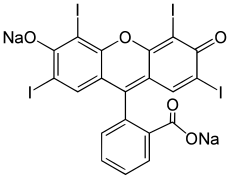This is an old revision of this page, as edited by CheMoBot (talk | contribs) at 14:19, 19 May 2011 (Updating {{chembox}} (changes to watched fields - updated 'ChEMBL_Ref', 'KEGG_Ref') per Chem/Drugbox validation (report errors or [[user talk:CheMoBot|bug). The present address (URL) is a permanent link to this revision, which may differ significantly from the current revision.
Revision as of 14:19, 19 May 2011 by CheMoBot (talk | contribs) (Updating {{chembox}} (changes to watched fields - updated 'ChEMBL_Ref', 'KEGG_Ref') per Chem/Drugbox validation (report errors or [[user talk:CheMoBot|bug)(diff) ← Previous revision | Latest revision (diff) | Newer revision → (diff)
| |
| Names | |
|---|---|
| IUPAC name 2-(6-Hydroxy-2,4,5,7-tetraiodo-3-oxo-xanthen-9-yl)benzoic acid | |
| Identifiers | |
| CAS Number | |
| 3D model (JSmol) | |
| ChemSpider | |
| ECHA InfoCard | 100.036.390 |
| E number | E127 (colours) |
| PubChem CID | |
| UNII | |
| CompTox Dashboard (EPA) | |
InChI
| |
SMILES
| |
| Properties | |
| Chemical formula | C20H6I4Na2O5 |
| Molar mass | 879.86 g/mol |
| Except where otherwise noted, data are given for materials in their standard state (at 25 °C , 100 kPa).
| |
Erythrosine, also known as Red No. 3, is an organoiodine compound, specifically a derivative of fluorone. It is cherry-pink synthetic, primarily used for food coloring. It is the disodium salt of 2,4,5,7-tetraiodofluorescein. Its maximum absorbance is at 530 nm in an aqueous solution, and it is subject to photodegradation.
Uses
It is used as a food coloring, in printing inks, as a biological stain, a dental plaque disclosing agent and a radiopaque medium. Erythrosine is commonly used in sweets such as some candies and popsicles, and even more widely used in cake-decorating gels. It is also used to color pistachio shells. As a food additive, it has the E number E127.
While commonly used in many countries of the world, erythrosine is less commonly used in the United States because Allura Red AC (Red #40) is generally used instead. However, Allura Red AC is banned in many European countries because it is an azo dye, despite the fact that it has fewer known health risks than erythrosine.
As a result of efforts begun in the 1970s, in 1990 the U.S. FDA had instituted a partial ban on erythrosine, citing research that high doses have been found to cause cancer in rats. In June of 2008, the Center for Science in the Public Interest (CSPI) petitioned the FDA for a complete ban on erythrosine in the United States.
A series of toxicology tests combined with a review of other reported studies concluded that erythrosine is non-mutagenic.
Synonyms
Erythrosine B; Erythrosin B; Acid Red 51; C.I. 45430; FD & C Red No.3; E127; 2',4',5',7'-Tetraiodo-3',6'-dihydroxy-spiro-3-one disodium salt; Tetraiodofluorescein Sodium Salt; Calcoid Erythrosine N; 2,4,5,7-Tetraiodo-3,6-dihydroxyxanthene-9-spiro-1'-3H-isobenzofuran-3'-one disodium salt; 2',4',5',7'-Tetraiodofluorescein, disodium salt; C.I.Food Red 14; Aizen Erythrosine; Tetraiodifluorescein, disodium salt; Spiroxanthen]-3-one, 3',6'-dihydroxy-2',4',5',7'-tetraiodo-, disodium salt.
Classification
It is listed under the following number systems:
- FD&C Red No. 3
- E number E127 (Food Red 14)
- Color Index no. 45430 (Acid Red 51)
- Indian Standards No. 1697
References
- Phyllis A. Lyday "Iodine and Iodine Compounds" in Ullmann's Encyclopedia of Industrial Chemistry, 2005, Wiley-VCH, Weinheim
- Food Color Additives
- Food Product Design Article
- Blue Diamond Ultra Premium Blend Mixed Nuts, distributed by Diamond Foods, Inc. Stockton, CA
- FDA: Red Dye's Reluctant Regulator; Partial Ban Points to Limitations of 30-Year-Old Delaney Clause, The Washington Post, February 7, 1990
- FDA Urged To Ban Some Food Dyes, CBS News, June 3, 2008
- Lin, George H. Y.; Brusick, David J. (1986). "Mutagenicity studies on FD&C Red No.3". Mutagenesis. 1 (4): 253–259. doi:10.1093/mutage/1.4.253. PMID 2457780.
- Erythrosin B, University of South Carolina
- Erythrosine, chemicalland21.com
External links
- Bureau of Indian Standards: List of Indian Standards under mandatory certification
- Some more details, other common names